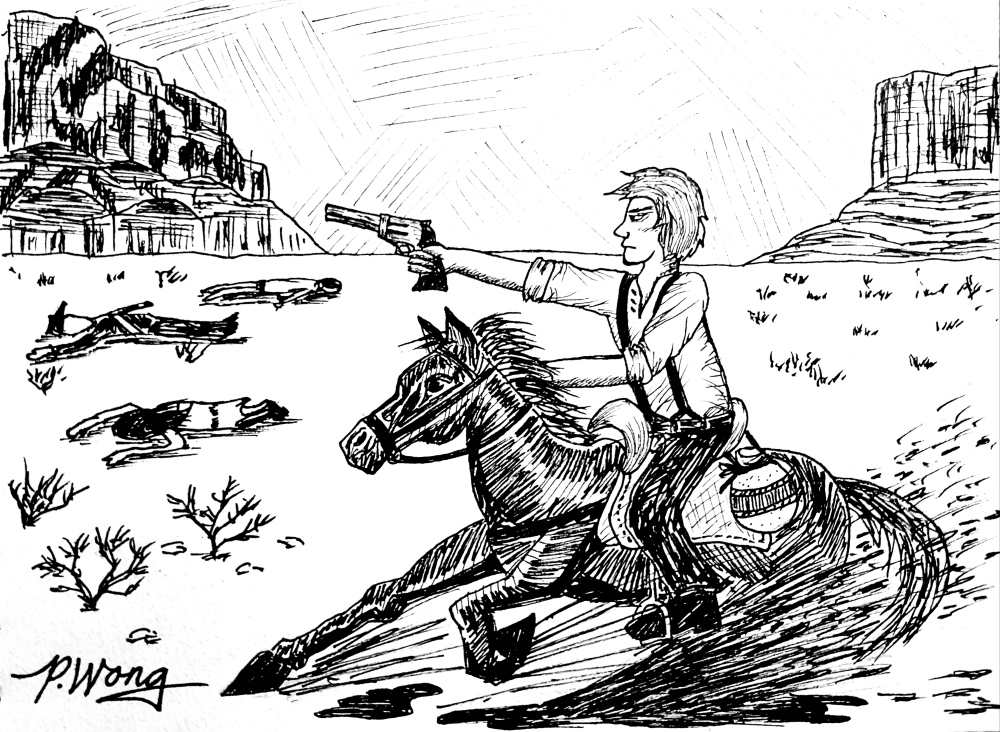Image Description: A man holds a pistol in his extended arm while hiding a horse. They are in the desert, with three bodies lying dead on the ground.
By Mikey Isitt
‘The kid’ is the main character of Blood Meridian (1985), Cormac McCarthy’s wild west nightmare-odyssey. We never find out the kid’s name. He’s an archetype. Raised on “mindless violence,” he falls in with a gang that commits unspeakable evils. He’s complicit in their crimes, but there’s something different about this teenage Tennesseean. A glimmer of morality lies under the surface. Judge Holden, the main antagonist of the piece, and a real dickhead, is eventually undermined by this morality.
CORMAC HATES COMMAS
Reading this book for the first time, you relate to the kid the most. There’s a lotta shit going on— symbolism, religion, warfare, and dense blocks of run-on sentences (with not a comma in sight)— and you’re in the middle of it all, just toiling alongside. Not that the book is tedious; McCarthy creates a sublime, menacing landscape, rife with danger. Pictures of violence and death appear without warning, at well-timed intervals. It’s an exhausting, relentless read. Self-inserting as the kid, you’re coming along for the ride, and the objective is, simply, to survive.
THE KID IN THE WIDER CULTURE
We’ve seen the kid before, all around us. Think Jim Stark (James Dean’s character in Rebel Without a Cause), Anakin Skywalker, James Bond, or Ryan Gosling’s character from the movie Drive. These are tormented young men with violent streaks, plagued by seemingly inescapable circumstances, but in their heart of hearts trying to be good people. They stand up to evil figures of authority, when nobody else is brave (or foolish) enough, just like how the kid opposes the judge and his warped world views. “Judge of what?” spits the kid.
REDEMPTION
Why are these characters so popular? It’s the idea of redemption. When the bad boy gives up his violent ways, and becomes a force for good in the world, it’s inspiring. It feeds us a saccharine story about how anyone can be ‘A Real Hero,’ and that it’s never too late to change. Shit’s like heroin for the soul. Bad boys, however, rarely achieve a happy ending. Countless rock stars die from overdoses. Anakin can’t escape the grip of the Dark Side. The Driver’s violent life prevents him from establishing a fulfilling connection, same goes for Bond. Jim Stark loses his newfound friend, and James Dean dies in a car crash. It’s a tragic, seemingly unshakeable narrative. The kid is no different.
THE KID IS DOOMED
We all wanna be bad at some point in our life, despite the warnings we see in pop culture. We love to explore our dark side, and it is healthy to do so. But eventually we must put the bumbag down and take off our Nike Tns. The bad boy is, after all, a trope and a myth. The Take recently made a brilliant video about this very topic, and the lessons we learn from these characters. It’s worth a watch.
So, what can we learn from the kid? The main takeaway is that bad boys are created in harrowing circumstances, born from trauma, and not an ideal to strive towards. They can, however, find redemption. Just don’t expect a Hollywood ending.
Mikey Isitt is going round, taking names.
Image courtesy of Pauline Wong.

